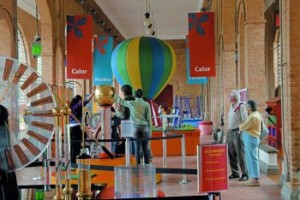
EDUARDO CESARCatavento: installations include everything from astronomy to biology, from history to engineeringEDUARDO CESAR
A place for disseminating science and knowledge has opened in the center of the city of Sao Paulo; the Catavento Space offers the public 250 installed facilities spread over an area of 8,000 sq m. The museum, which is located in the Palace of Industries, an imposing building erected in the 1920s in D. Pedro II Park, which already houses the Legislative Assembly, the Department of Security and the city hall, is very interactive, using videos, panels and models to bring children and young people closer to science and technology in an enjoyable way. Resulting from a partnership between the State departments of Culture and Education, the space has received public investment to the tune of R$ 14 million and is administered by a social organization. “The objective is to stimulate, provoke and create new sensations for visitors”, explains state secretary of Culture, João Sayad.
Each of the four sections has an independent entrance. As this is a very large exhibition that can take up to a whole day to view in depth, the idea is to divide the experience into several visits, without any repetition of the content. In the Universe section, dozens of optical fibers simulate the sky on a starry winter’s night in São Paulo. Visitors sit on poufs and with the help of monitors, learn to recognize the constellations using a celestial chart. It is also possible to touch the meteorite fragment found in Argentina, and which fell to Earth some 6000 years ago; look at a 1.2 meter diameter model that shows the details of the Sun, complete with sunspots; or step on a reproduction of the first footstep of man on the moon, as immortalized by astronaut Neil Armstrong in 1969. In an exercise that associates astronomy and geography, it is possible to squeeze the stars that form part of the Brazilian flag and find out which state they represent.
In the Life section there are sea-water aquaria with sea anemones, coral and carnivorous and poisonous fish, an installation with 700 Amazonian butterflies provided by the Emílio Goeldi Para Museum and a space in which visitors can select birds on a computer screen and hear their song through earphones. In the Inventions Section the highlights are the Van der Graaf generator, which makes your hair stand on end when you touch it, a balloon that rises off the ground and a room dedicated to optical illusions. A prism shows how white light breaks up into the seven colors we see in a rainbow. Finally, in the Society section there is the Blue Room, a space that was preserved in accordance with the restoration plan carried out by Lina Bo Bardi in 1992. This is the most interactive area in the museum, with question and answer games that have current themes; the Portinari panel, on which, with the help of a brush with an infrared sensor, visitors can paint the wall, thus revealing works of the painter and historical facts about him. There is also a gallery of historical characters, in which the visitor climbs a wall and gets close to portraits of personalities like Genghis Khan, Julius Cesar and Gandhi, who relate facts from their biographies. “The Catavento is a truly living school, which helps our understanding of how things function. It’s not only for children but for all those who want to understand more about the world of science”, says Sergio Freitas, one of the people whose brainchild the museum was and Chairman of the Board of the Catavento Cultural and Educational organization.
Some of the interactive installations can be handled without help, while others need guides. Teachers and monitors organize games, demonstrate chemical experiments or help manipulate the gadgets that prove the laws of physics. The 180-seater auditorium is set up for talks and courses.
The initiative takes advantage of a series of successful experiences. A piece from the Darwin Exhibition at the São Paulo Museum of Art in 2007 was included in the Life section. The School of Medicine Foundation supplied the structures of the human body in three-dimensional images from its Virtual Man installation. In the Nanoadventure space, a branch of the interactive exhibition of nanosciences and nanotechnology created by researchers from the State University of Campinas and the National Synchrotron Light Laboratory (LNLS), visitors get involved in a competition of knowledge and skill relating to microorganisms and minute objects. The museum received support from other institutions, like the Astronomy Institute of the University of São Paulo (USP), which supplied material and technical support for the whole of the Universe area, USP’s Polytechnic School that created the Digital Walk, a three-dimensional trip around Rio de Janeiro, or the Kaplan Institute that was responsible for the installation concerning pregnancy in adolescence and sexually-transmitted diseases.
The exhibition is recommended for children from 6 years of age, but people of all ages can have fun and learn. Only the installation about sexuality, in the Society section, is restricted to those over 13. The main target public are the 8 million pupils of the state education system. The space is part of the ‘Culture is Curriculum’ program of the Department of Education, aimed at democratizing access to cultural heritage for teachers and pupils from public schools and diversifying learning situations. It is estimated that at least 1 million students will visit the exhibition in its first year. “This is a huge number, but education always makes demands that are much bigger than we’re capable of meeting”, says secretary, João Sayad, According to the secretary the inspiration for Catavento came from the La Villette City of Sciences and Industry in Paris, the world’s biggest natural science exhibition center.
Republish
